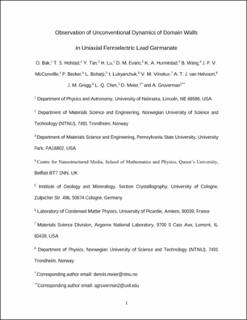Observation of Unconventional Dynamics of Domain Walls in Uniaxial Ferroelectric Lead Germanate
Bak, Ohheum; Holstad, Theodor Secanell; Lu, Haidong; Evans, Donald; Hunnestad, Kasper Aas; Wang, Bo; Becker, Petra; Bohatý, Ladislav; Helvoort, Antonius T. J. van; Gregg, J Marty; Meier, Dennis Gerhard; Gruverman, Alexei
Peer reviewed, Journal article
Accepted version

Åpne
Permanent lenke
https://hdl.handle.net/11250/2722464Utgivelsesdato
2020Metadata
Vis full innførselSamlinger
- Institutt for fysikk [2685]
- Institutt for materialteknologi [2544]
- Publikasjoner fra CRIStin - NTNU [37957]
Originalversjon
10.1002/adfm.202000284Sammendrag
Application of scanning probe microscopy techniques such as piezoresponse force microscopy (PFM) opens the possibility to re‐visit the ferroelectrics previously studied by the macroscopic electrical testing methods and establish a link between their local nanoscale characteristics and integral response. The nanoscale PFM studies and phase field modeling of the static and dynamic behavior of the domain structure in the well‐known ferroelectric material lead germanate, Pb5Ge3O11, are reported. Several unusual phenomena are revealed: 1) domain formation during the paraelectric‐to‐ferroelectric phase transition, which exhibits an atypical cooling rate dependence; 2) unexpected electrically induced formation of the oblate domains due to the preferential domain walls motion in the directions perpendicular to the polar axis, contrary to the typical domain growth behavior observed so far; 3) absence of the bound charges at the 180° head‐to‐head (H–H) and tail‐totail (T–T) domain walls, which typically exhibit a significant charge density in other ferroelectrics due to the polarization discontinuity. This strikingly different behavior is rationalized by the phase field modeling of the dynamics of uncharged H–H and T–T domain walls. The results provide a new insight into the emergent physics of the ferroelectric domain boundaries, revealing unusual properties not exhibited by conventional Ising‐type walls.